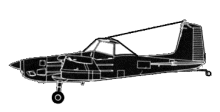
ASN Wikibase Occurrence # 309948
This information is added by users of ASN. Neither ASN nor the Flight Safety Foundation are responsible for the completeness or correctness of this information.
If you feel this information is incomplete or incorrect, you can submit corrected information.
| Date: | Thursday 12 July 2018 |
| Time: | 16:47 LT |
| Type: |  Cessna A188B |
| Owner/operator: | Private |
| Registration: | N2483J |
| MSN: | 18803467T |
| Year of manufacture: | 1979 |
| Total airframe hrs: | 7641 hours |
| Engine model: | Continental IO-550-D |
| Fatalities: | Fatalities: 0 / Occupants: 1 |
| Aircraft damage: | Minor |
| Category: | Serious incident |
| Location: | Rockford, Ohio -
 United States of America United States of America
|
| Phase: | Manoeuvring (airshow, firefighting, ag.ops.) |
| Nature: | Agricultural |
| Departure airport: | Celina-Lakefield Airport, OH (KCQA) |
| Celina-Lakefield Airport, OH (KCQA) | |
| Investigating agency: | NTSB |
| Confidence Rating: |
The commercial pilot of the aerial application flight reported that the airplane was at 350 ft above ground level when the engine started running roughly and then lost total power. He executed a forced landing to a field, which resulted in minor damage to the right wing.
A review of the engine maintenance logbooks indicated that the accident occurred 107.6 hours after all six cylinders were replaced. The engine teardown examination revealed a large hole in the crankcase near the No. 2 cylinder. The crankcase bearing supports exhibited signs consistent with bearing shift. The No. 2 and No. 3 lock tabs exhibited elongation, and all bearing support mating surfaces exhibited varying amounts of fretting, with the No. 2 and No. 3 surfaces displaying the most fretting. The No. 3 bearing had shifted a significant amount, and part of the bearing was separated. The No. 2 connecting rod bearings exhibited a significant amount of thermal damage consistent with heat distress. The No. 2 connecting rod was separated from its journal and exhibited damage consistent with lubrication distress. The No. 2 piston was separated from the connecting rod and remained in the cylinder.
It is likely that, when all six cylinders were replaced, the engine's through-bolts did not have sufficient clamping force, which resulted in movement of the crankcase halves as evidenced by the fretting on the crankcase bearing supports. This led to the crankcase main bearings shifting, which resulted in oil starvation to the No. 2 connecting rod journal, failure of the No. 2 connecting rod, and the subsequent total loss of engine power.
Probable Cause: The total loss of engine power, which resulted from the separation of the No. 2 connecting rod due to oil starvation as a result of insufficient clamping force of the engine's through-bolts.
Accident investigation:
 |
|
Sources:
NTSB CEN18IA273
Location
Revision history:
| Date/time | Contributor | Updates |
|---|---|---|
| 01-Apr-2023 12:59 | ASN Update Bot | Added |
Corrections or additions? ... Edit this accident description
The Aviation Safety Network is an exclusive service provided by:


 ©2024 Flight Safety Foundation
©2024 Flight Safety Foundation